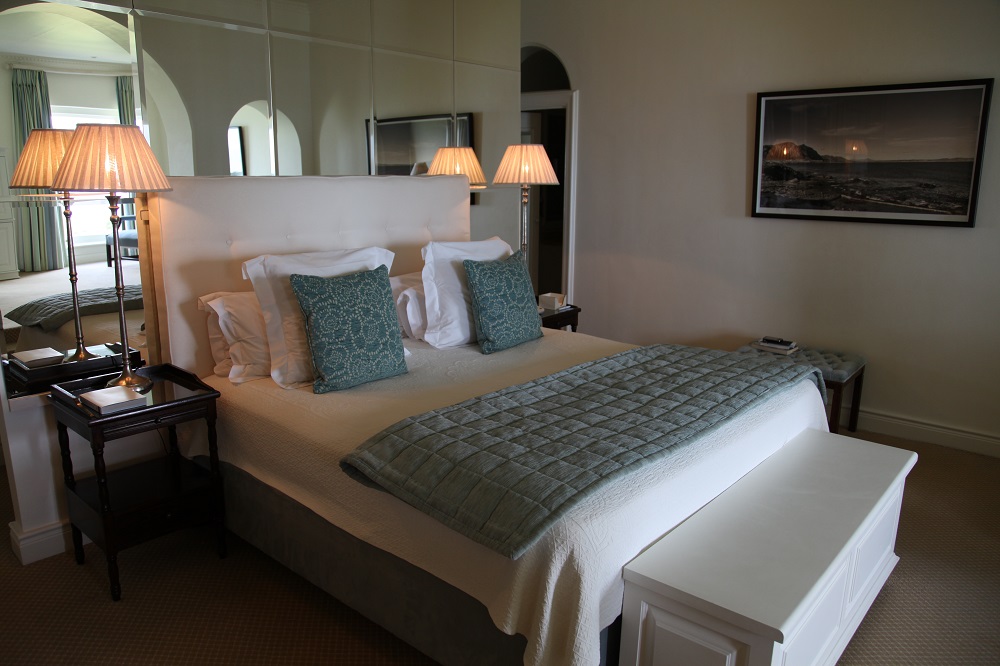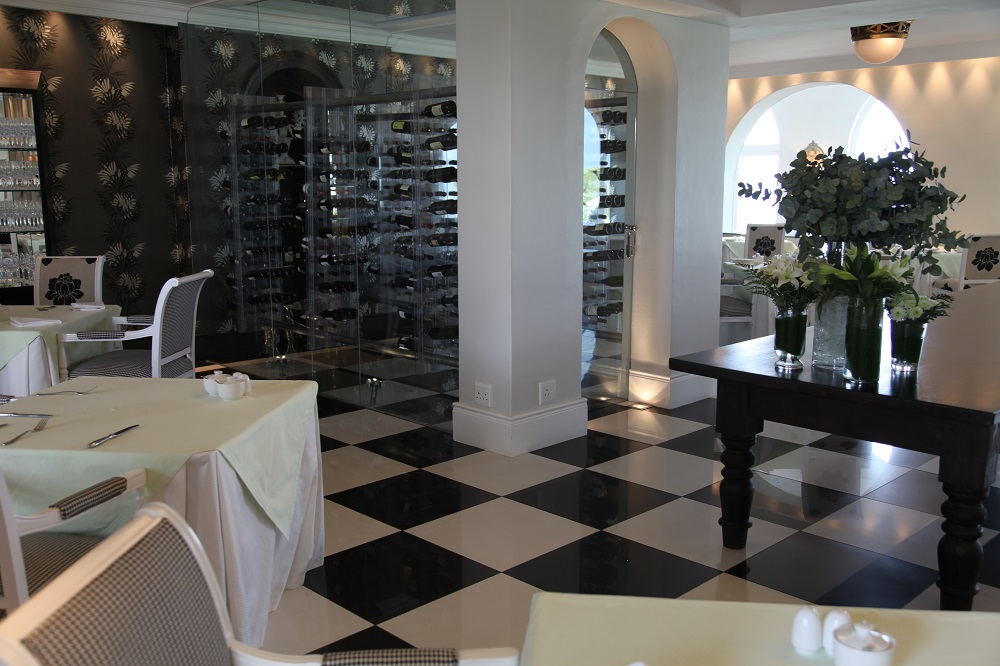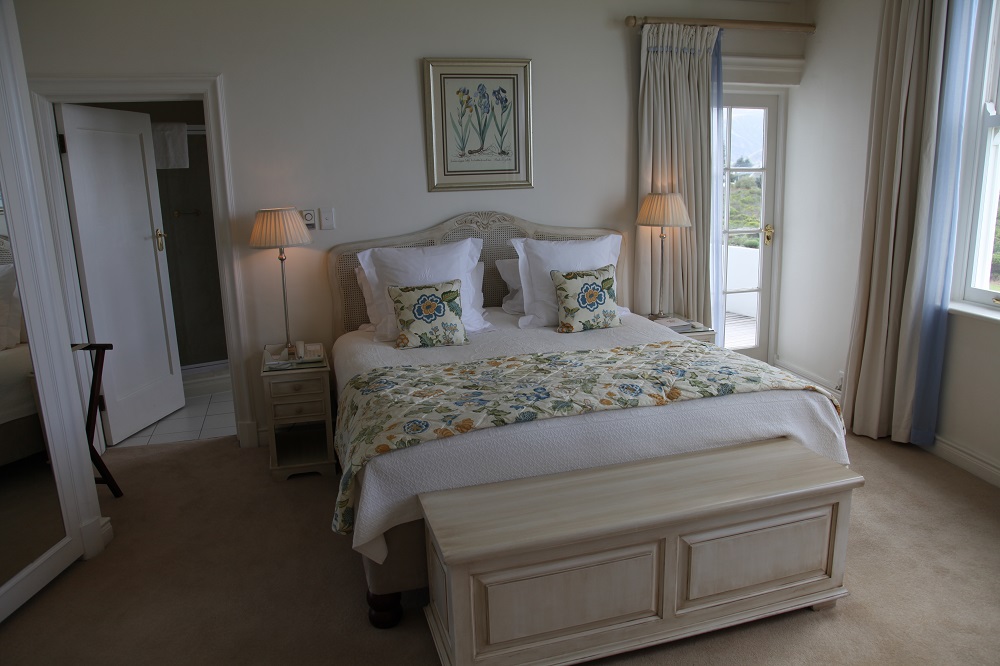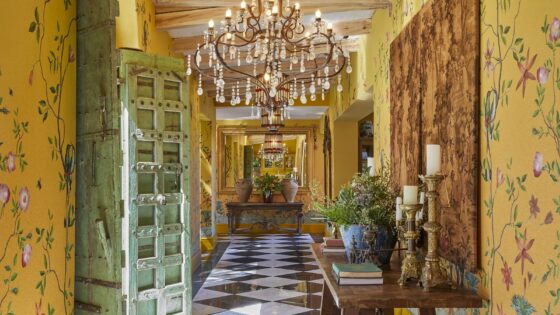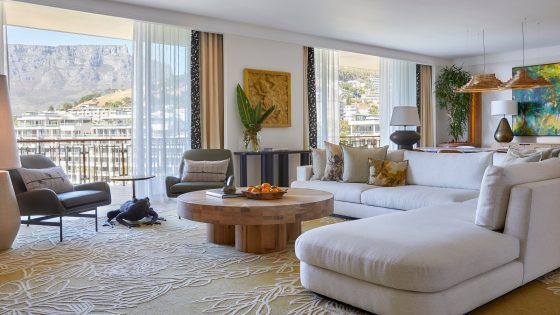Take a rundown neglected old hotel in an underexposed seaside resort, inject a soupçon of good design and watch it flower again. The Liz McGrath collection is achieving fabled status in South Africa by using good design to raise hotels into the first rank of global competition. Their Cellars Hohenort in Constantia Cape Town has been one of the city’s leading hotels for many years, and I kept hearing from South African friends that the Marine was special, both in its location and in the quality of the interiors. So, climbing into a borrowed truck, I set out to see if it Liz McGrath’s design group could have done it again.
Hermanus is a small seaside resort on Walker Bay, off the famous garden route that runs from Cape Town to Port Elizabeth. One pleasant surprise from the start was an almost total absence of the electrified barbed wire which usually guarded gated estates. Neat housing developments have almost removed the ‘camps’ that so characterise areas like Hout Bay in Cape Town. Indeed driving into the town was a little like driving into some English seaside towns – a long road lined with housing, garages,churches, supermarkets and schools turning into narrow streets lined with fishmongers, restaurants, and all the typical small souvenir shops that characterise seaside resorts the world over.
The hotel sits in a prime location on the cliff top overlooking the bay where it was built in the 1920s. It looked very cool, its white exterior reflecting sunlight set against the greyblue stormy sky on the rainy winter day I arrived. The hotel gardens are actually a public space through which meanders the cliff walk, where people strolled with their binoculars, whale spotting and taking the air. An odd note was struck by the sight of a brown mongoose running along the path and the bay was flecked with whitecaps and sprays of flume as whales vented.
Entrance to the hotel was through a classical portico immediately inside which was the popular fish restaurant, the speciality restaurant of the hotel. To the right was the bar and lounge with whale bones on the wall as a reminder that Hermanus and this area have a long history supporting the fishing and whaling fleets going back into the 19th century. Huge windows overlooked the sea, and the building has had some major remodelling to open up the internal ground floor area to the narrow terrace and the views of the bay beyond the gardens.
The protea is the national flower of South Africa and was abundantly present in the public areas, providing a dramatic display at the end of the reception corridor as a visual ‘stop’.
Check in was smilingly efficient and we were taken to our room overlooking the bay. Almost immediately we saw a set of tail flukes flash, and realised that whale watching could comfortably be done from the bedroom window.
Comfort was the key note. The refurbishment of the hotel, which has taken in the ground floor areas first, is being steadily rolled out through the bedrooms. On my visit over half had been finished.
Housekeeping is excellent, and every hotelier knows that good housekeeping can extend the time between refurbishments by keeping an older scheme looking good for longer, and that is the case here. Where the rooms are new, this quality of care is maintaining a crispness to the furnishings which helps the stylish understated schemes impress.
Rooms are good sized and have large en-suite bathrooms with walk-in showers and large soaking tubs. With the rooms at the front looking over the bay it would be easy to say these were the best rooms and indeed a number of suites are on the front of the building. The view from the front looks out into the bay, down onto the water barely 100 metres in front of the hotel, a whale main road.
Rooms at the inland side of the central corridor spine look onto the pool and give a more resort feel to the hotel – and where there is no pool to see, frequently the view is into gardens with weavers’ nests in the trees.
Many of the rooms around the pool share a large terrace which runs around the building at first floor level and is large enough for generous tables and umbrellas to be used – when the weather suits. Even in the winter, as it was on my visit, the sun is hot and blue skies materialise with impressive speed, making the pool area attractive.
Restaurant dining also spills onto a lower pool terrace and there is a single storey spa building to the rear. On one side of the pool is a function room – a very large boardroom style area for private dining, meetings and functions. These areas all make the pool their focus.
The spa has a separate entrance which allows for a robust local business to grow. Under refurbishment on my visit, it is taking its design cues from other group spa’s and claiming the same spare elegance that drives the aesthetic in the bedrooms that have been refurbished. It is easy to see the growing family likeness with the newer bedrooms at Cellars Hohenort. Treatment rooms are quiet and restrained, lit by diffused sunlight through the blind-shaded windows giving a soft warm light.
The main restaurant which also has a terrace area onto the pool, together with its own pre-dinner drinks bar, is striking in its simple elegance, with clever lighting again echoing that used so successfully elsewhere in the group. The qualities of the menu and service set this apart from most seaside hotel experiences and its quality would embarrass many European hotels that should share this level of sophistication, but frequently fall short. Staff take pride in their skills and have an awareness of them that mixes easily with South African informality to give an impressive level of service.
With lighting cleverly allowing the candlelight to play its part the evening ambience is in keeping, whilst the alternative speciality restaurant offering is more bistro in style. In the mornings the huge picture windows of the main restaurant change the feel, flooding it with light.
This use of light and balance with candlelight is seen in the bar and its lounge. By day a typical seaside bar area with its terrace overlooking the sea, at night it transofrms into the sophisticated heart of a sophisticated restaurant and hotel operation.
By night the lighting transforms the look of the spaces, the cleverly lit bar appearing almost to take its cues from the famous Blue Bar in the MayFair in London’s fashionable West End, unexpected in a small seaside resort.The saloon owes no part of its comfortable sophistication to elsewhere though, the open fire and strong use of imagery through to the colour of fabrics being a Liz McGrath hallmark design, with the focus very much on creating a comfortable guest environment.
“local knowledge and designers will certainly make it difficult for the chain hotels to compete”
The Liz McGrath Collection is one of the premier hotel groupings in South Africa, and have led the development of the tourism industry at a five star level for many years.
Most of the staff area recruited and trained locally, given the opportunity to rise in the company and become leaders in the South African hospitality world. Using local and in house designers is also making the group a leader in design terms, something that has been recgnised by a steady stream of awards over the years.
Whilst major brands develop their presence in South Africa, local businesses are showing that they can compete not only at a local level, but win accolades on the global stage too as Liz McGraths Collection has done. This is true also of Red Carnation in Bushmans Kloof (despite its London Head Office the origins of the company are in South Africa)and Wilderness Hotels through their 60+ operations across the south of the continent, including Damaraland in Namibia, all of which work closely with local communities and locations.
With regional tourism growing at 8 – 10 per cent a year (Tanzania in 2008 for example grew by 17+ per cent)the local knowledge and designers will certainly make it difficult for the chain hotels to compete on quality for a share of the market. On quality they will need to look hard at their self proclaimed standards against true five star service such as that epitomised by the Marine Hermanus
Owner developer: Liz McGrath.
Design leadership rests with Mrs. McGrath, but as with other strong leaders she has an equally strong team in her interior designers, who are Dawn Dickerson and Carmel Naude of Hotcocoa in Johannesburg.


